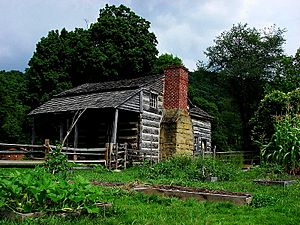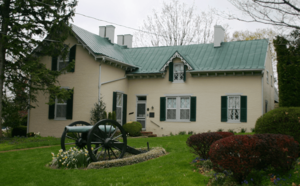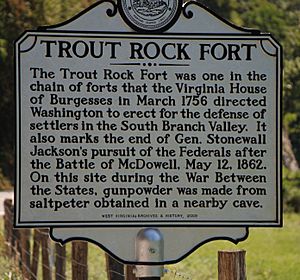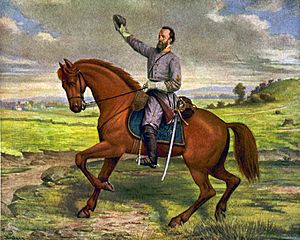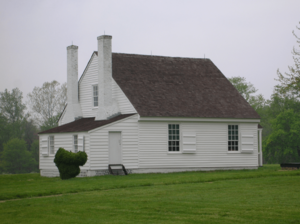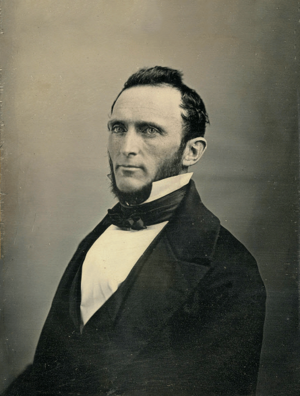Stonewall Jackson facts for kids
Quick facts for kids
Thomas Jonathan Jackson
|
|
|---|---|
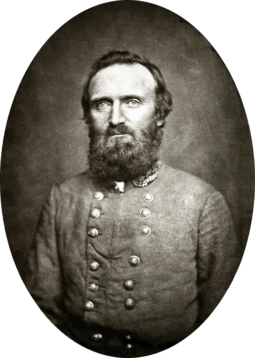
General Jackson photographed at Winchester, Virginia 1862
|
|
| Nickname(s) | "Stonewall", "Old Jack", "Old Blue Light", "Tom Fool" |
| Born | January 21, 1824 Clarksburg, Virginia, U.S. (now Clarksburg, West Virginia) |
| Died | May 10, 1863 (aged 39) Guinea Station, Virginia |
| Buried |
Stonewall Jackson Memorial Cemetery
Lexington, Virginia, U.S. |
| Allegiance | United States of America (1846–1851) Confederate States of America (1861–1863) |
| Service/ |
|
| Years of service |
|
| Rank | |
| Commands held | |
| Battles/wars | Mexican–American War American Civil War
|
| Signature | |
Thomas Jonathan "Stonewall" Jackson (born January 21, 1824 – died May 10, 1863) was a famous general for the Confederate side during the American Civil War. Many people consider him the most well-known Confederate commander after General Robert E. Lee. He was a key leader in almost all the major battles in the eastern part of the war until he died. Military experts believe he was one of the best battle planners in U.S. history.
On May 2, 1863, Jackson was accidentally shot by his own soldiers. He had to have his left arm removed. He became very weak from his injuries and died eight days later from pneumonia. His death was a big loss for the Confederacy.
Contents
Early Life of Thomas Jackson
Thomas Jackson was born in Clarksburg, Virginia, on January 21, 1824. He was the third child of Julia Beckwith Jackson and Jonathan Jackson, who was a lawyer.
Thomas's sister Elizabeth died from typhoid fever in 1826. His father also died from typhoid fever in 1827. Jackson's mother, Julia, was left with three young children and many debts. She sold their belongings to pay off the debts. Julia worked as a seamstress and opened a small school to support her family.
In 1830, Julia got married again. Her new husband, Captain Blake B. Woodson, did not like his stepchildren. Julia was often sick, so she let her children go live with their Grandmother Jackson.
The next year, Julia died, leaving her three older children without parents.
After his mother's death, Thomas and his sister Laura Ann were separated. Laura Ann went to live with their mother's family. Thomas went to live with his Aunt Polly and her husband, Isaac Brake. Thomas was not treated well by Brake and ran away after a year. He walked eighteen miles to his half-uncle Cummins Jackson's mill in Lewis County. He lived there for the next seven years.
Jackson helped on the farm, taking care of sheep and helping with crops. He taught himself a lot of what he knew. Later, he even worked as a schoolteacher at Jackson's Mill.
Military Career and "Stonewall" Nickname
In 1842, Jackson was accepted into the United States Military Academy at West Point. He worked very hard and graduated 17th in his class in 1846.
Jackson started his United States Army career as a second lieutenant. He fought in the Mexican–American War at battles like the Siege of Veracruz and the Battle of Mexico City. He earned promotions and became a first lieutenant. It was in Mexico that Jackson first met Robert E. Lee.
In 1851, Jackson became a teacher at the Virginia Military Institute (VMI). He taught physics and artillery.
Joining the Civil War
In April 1861, Jackson was made a Colonel of Virginia Infantry. Soon after, he was promoted to Colonel in the Confederate Army.
Virginia Governor John Letcher ordered Colonel Jackson to take command at Harpers Ferry. There, he put together the unit that later became known as the "Stonewall Brigade". Jackson was famous for training his troops very strictly. He believed that discipline was key to winning battles.
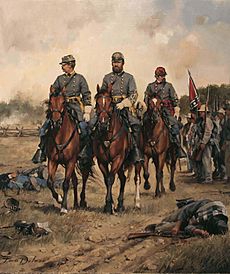
Jackson became very famous and earned his nickname, "Stonewall Jackson," at the First Battle of Bull Run (First Manassas) on July 21, 1861. When the Confederate lines started to break, Jackson's brigade, the Stonewall Brigade, arrived and helped stop the Union attack. They suffered more losses than any other Southern group that day. During the battle, Jackson held his left arm up, which his soldiers saw as a sign of his strong will. His hand was hit by a bullet, but he refused to have his finger amputated. After the battle, Jackson was promoted to major general and given command of the Valley District.
In the spring of 1862, Union General George B. McClellan's army moved toward Richmond. Other Union armies also threatened the area. Jackson was ordered to fight in the Shenandoah Valley to stop these threats.
Jackson knew the land very well and used it smartly. He was also great at inspiring his soldiers to march and fight hard. He won five important battles with about 17,000 men against 60,000 Union soldiers. Union forces then left the Valley.
Jackson's ability to move his troops so quickly earned them the nickname "foot cavalry". He became the most celebrated soldier in the Confederacy and boosted the spirits of the Southern people.
At the Battle of Chancellorsville, General Lee and Jackson faced a strong Union army. Lee decided to take a big risk and split his forces. Jackson and his entire corps marched around the Union lines. This surprise attack was one of the most successful of the war. Jackson's men charged into the Union position, catching many soldiers off guard. They captured many and forced the rest to retreat. Jackson chased them until it got dark.
Jackson was hit by three bullets: two in his left arm and one in his right hand. His left arm had to be removed.
Death of Stonewall Jackson
Jackson died from problems caused by pneumonia on May 10, 1863. This was eight days after he was shot.
The bullet that hit Jackson was found to be a type used by Confederate forces. Union troops in the area used different bullets. This helped show that he was accidentally shot by his own side.
His body was taken to the Governor's Mansion in Richmond for people to mourn. Then, he was buried in Oak Grove Cemetery in Lexington, Virginia. His amputated arm was buried separately by his chaplain at the J. Horace Lacy house, "Ellwood."
Views on Slavery
In 1855, Jackson started Sunday School classes for Black people at his Presbyterian Church. His second wife, Mary Anna Jackson, also taught with him. He called his students by their names, and they called him "Marse Major."
Jackson owned six enslaved people in the late 1850s. Historian James Robertson wrote that Jackson did not apologize for slavery. He believed that God had allowed slavery, and people should not challenge it. He thought a good Christian slaveholder treated enslaved people fairly and kindly.
Family Life
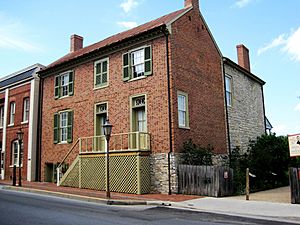
In 1853, Thomas Jackson married Elinor "Ellie" Junkin. Ellie gave birth to a stillborn son in 1854.
After a trip to Europe, Jackson married again in 1857. His new wife was Mary Anna Morrison. She had a daughter named Mary Graham in 1858, but the baby died less than a month later. Another daughter, Julia Laura, was born in 1862, shortly before Jackson's death.
Jackson bought the only house he ever owned in Lexington in 1859. He lived there for two years before joining the Confederate army. Jackson never returned to his home.
Command Style
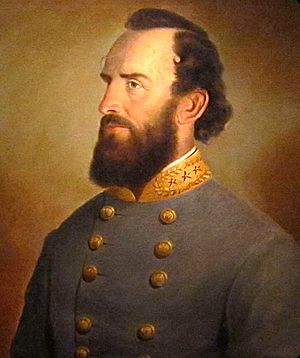
Jackson kept his battle plans very secret. This often made it hard for his officers, who usually didn't know his full plans until the last minute.
General Robert E. Lee trusted Jackson with general orders. Jackson had a special skill for understanding Lee's goals, even when they weren't fully explained. Lee knew Jackson would do what was needed. Few of Lee's later commanders had this ability. For example, at the Battle of Gettysburg, a new commander, Richard S. Ewell, was told to take some high ground "if practicable." Without Jackson's understanding, Ewell chose not to attack. Many historians believe this was a big missed chance in the battle.
Interesting Facts About Stonewall Jackson
- Jackson was not a popular teacher. His students nicknamed him "Tom Fool" because he would memorize his lectures and repeat them. If a student asked for help, he would just repeat the same explanation slower.
- Before the Battle of Fredericksburg, Jackson was given a fancy new general's coat. His old coat was worn out. Jackson refused to wear the new one for months, saying it was "too handsome" for him.
- One of Jackson's nicknames was "Old Blue Lights." This name was given to military men who were very enthusiastic, like the bright blue light used for night signals.
- When Robert E. Lee heard about Jackson's death, he said, "William, I have lost my right arm," and "I'm bleeding at the heart."
- Jackson believed one of his arms was longer than the other. He often held that arm up to help his blood flow.
- He was known as a "champion sleeper" and sometimes even fell asleep while eating.
- A common story says Jackson loved lemons. He would supposedly chew them whole to help with his indigestion.
- Jackson's horse was named "Little Sorrel." He rode this small chestnut horse throughout the war. He was riding Little Sorrel when he was shot at Chancellorsville. Little Sorrel lived to be 36 years old and is buried near a statue of Jackson at VMI.
- Jackson's wife, Mary Anna Jackson, wrote two books about his life. She never remarried and was known as the "Widow of the Confederacy." She lived until 1915.
- Jackson's last words, "Let us cross over the river, and rest under the shade of the trees," inspired the title of Ernest Hemingway's 1950 novel Across the River and into the Trees.
Legacy and Commemorations
Many people have wondered if Lee might have won at Gettysburg if Jackson had lived. His discipline and battle skills were certainly missed.
General George S. Patton (from World War II) prayed next to pictures of Robert E. Lee and Stonewall Jackson as a boy. He thought they were God and Jesus. General Douglas MacArthur called Robert L. Eichelberger his Stonewall Jackson.
Jackson is a key figure in the "Lost Cause" idea. He has been honored in many ways, including with statues, money, and stamps. A poem from the war, "Stonewall Jackson's Way," became a popular song. The Stonewall Brigade Band still performs today.
West Virginia's Stonewall Jackson State Park is named after him. Near his childhood home, his uncle's mill is now part of the Jackson's Mill Center for Lifelong Learning and State 4-H Camp. This site is used by West Virginia University.
In 1921, U.S. Marines were training in Virginia. A local farmer told General Smedley Butler that Stonewall Jackson's arm was buried nearby. Butler dug up the spot and found the arm. He replaced the wooden box with a metal one and reburied it. He left a plaque marking the spot.
From 1904, Virginia celebrated Jackson's birthday as a state holiday. This holiday was removed in July 2020.
Jackson is shown on the 1925 Stone Mountain Memorial half-dollar.
A Stonewall Jackson Monument was put up in Richmond, Virginia, in 1919. It was removed on July 1, 2020, during the 2020–2021 United States racial unrest.
Images for kids
-
General Jackson's "Chancellorsville" portrait, taken on April 26, 1863, seven days before he was wounded at the Battle of Chancellorsville
-
The 1863 sheet music The Stonewall Brigade, Dedicated to the Memory of Stonewall Jackson, the Immortal Southern Hero, and His Brave Veterans
-
Davis, Lee, and Jackson on Stone Mountain
-
The Thomas Jonathan Jackson sculpture in downtown Charlottesville, Virginia
-
Statue of Jackson in downtown Clarksburg, West Virginia
-
The Stonewall Jackson Monument in Richmond, Virginia being removed in 2020
-
Jackson reading the Bible in a Confederate camp in a stained glass window of the Washington National Cathedral. The windows were removed in 2017.
See also
 In Spanish: Thomas Jonathan Jackson para niños
In Spanish: Thomas Jonathan Jackson para niños


